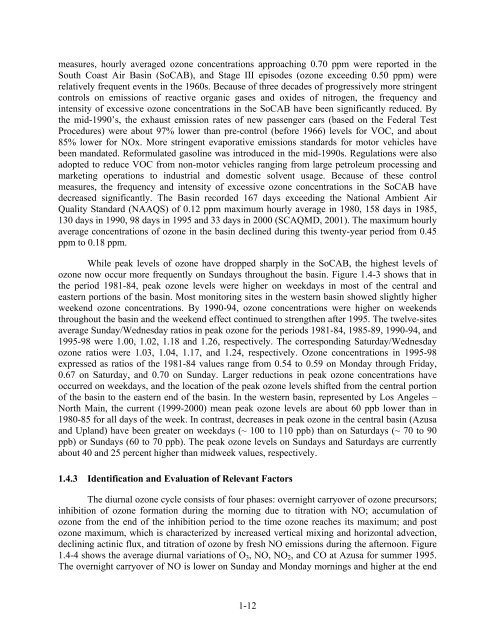Weekend/Weekday Ozone Observations in the South Coast Air Basin
Weekend/Weekday Ozone Observations in the South Coast Air Basin
Weekend/Weekday Ozone Observations in the South Coast Air Basin
Create successful ePaper yourself
Turn your PDF publications into a flip-book with our unique Google optimized e-Paper software.
measures, hourly averaged ozone concentrations approach<strong>in</strong>g 0.70 ppm were reported <strong>in</strong> <strong>the</strong><br />
<strong>South</strong> <strong>Coast</strong> <strong>Air</strong> Bas<strong>in</strong> (SoCAB), and Stage III episodes (ozone exceed<strong>in</strong>g 0.50 ppm) were<br />
relatively frequent events <strong>in</strong> <strong>the</strong> 1960s. Because of three decades of progressively more str<strong>in</strong>gent<br />
controls on emissions of reactive organic gases and oxides of nitrogen, <strong>the</strong> frequency and<br />
<strong>in</strong>tensity of excessive ozone concentrations <strong>in</strong> <strong>the</strong> SoCAB have been significantly reduced. By<br />
<strong>the</strong> mid-1990’s, <strong>the</strong> exhaust emission rates of new passenger cars (based on <strong>the</strong> Federal Test<br />
Procedures) were about 97% lower than pre-control (before 1966) levels for VOC, and about<br />
85% lower for NOx. More str<strong>in</strong>gent evaporative emissions standards for motor vehicles have<br />
been mandated. Reformulated gasol<strong>in</strong>e was <strong>in</strong>troduced <strong>in</strong> <strong>the</strong> mid-1990s. Regulations were also<br />
adopted to reduce VOC from non-motor vehicles rang<strong>in</strong>g from large petroleum process<strong>in</strong>g and<br />
market<strong>in</strong>g operations to <strong>in</strong>dustrial and domestic solvent usage. Because of <strong>the</strong>se control<br />
measures, <strong>the</strong> frequency and <strong>in</strong>tensity of excessive ozone concentrations <strong>in</strong> <strong>the</strong> SoCAB have<br />
decreased significantly. The Bas<strong>in</strong> recorded 167 days exceed<strong>in</strong>g <strong>the</strong> National Ambient <strong>Air</strong><br />
Quality Standard (NAAQS) of 0.12 ppm maximum hourly average <strong>in</strong> 1980, 158 days <strong>in</strong> 1985,<br />
130 days <strong>in</strong> 1990, 98 days <strong>in</strong> 1995 and 33 days <strong>in</strong> 2000 (SCAQMD, 2001). The maximum hourly<br />
average concentrations of ozone <strong>in</strong> <strong>the</strong> bas<strong>in</strong> decl<strong>in</strong>ed dur<strong>in</strong>g this twenty-year period from 0.45<br />
ppm to 0.18 ppm.<br />
While peak levels of ozone have dropped sharply <strong>in</strong> <strong>the</strong> SoCAB, <strong>the</strong> highest levels of<br />
ozone now occur more frequently on Sundays throughout <strong>the</strong> bas<strong>in</strong>. Figure 1.4-3 shows that <strong>in</strong><br />
<strong>the</strong> period 1981-84, peak ozone levels were higher on weekdays <strong>in</strong> most of <strong>the</strong> central and<br />
eastern portions of <strong>the</strong> bas<strong>in</strong>. Most monitor<strong>in</strong>g sites <strong>in</strong> <strong>the</strong> western bas<strong>in</strong> showed slightly higher<br />
weekend ozone concentrations. By 1990-94, ozone concentrations were higher on weekends<br />
throughout <strong>the</strong> bas<strong>in</strong> and <strong>the</strong> weekend effect cont<strong>in</strong>ued to streng<strong>the</strong>n after 1995. The twelve-sites<br />
average Sunday/Wednesday ratios <strong>in</strong> peak ozone for <strong>the</strong> periods 1981-84, 1985-89, 1990-94, and<br />
1995-98 were 1.00, 1.02, 1.18 and 1.26, respectively. The correspond<strong>in</strong>g Saturday/Wednesday<br />
ozone ratios were 1.03, 1.04, 1.17, and 1.24, respectively. <strong>Ozone</strong> concentrations <strong>in</strong> 1995-98<br />
expressed as ratios of <strong>the</strong> 1981-84 values range from 0.54 to 0.59 on Monday through Friday,<br />
0.67 on Saturday, and 0.70 on Sunday. Larger reductions <strong>in</strong> peak ozone concentrations have<br />
occurred on weekdays, and <strong>the</strong> location of <strong>the</strong> peak ozone levels shifted from <strong>the</strong> central portion<br />
of <strong>the</strong> bas<strong>in</strong> to <strong>the</strong> eastern end of <strong>the</strong> bas<strong>in</strong>. In <strong>the</strong> western bas<strong>in</strong>, represented by Los Angeles –<br />
North Ma<strong>in</strong>, <strong>the</strong> current (1999-2000) mean peak ozone levels are about 60 ppb lower than <strong>in</strong><br />
1980-85 for all days of <strong>the</strong> week. In contrast, decreases <strong>in</strong> peak ozone <strong>in</strong> <strong>the</strong> central bas<strong>in</strong> (Azusa<br />
and Upland) have been greater on weekdays (~ 100 to 110 ppb) than on Saturdays (~ 70 to 90<br />
ppb) or Sundays (60 to 70 ppb). The peak ozone levels on Sundays and Saturdays are currently<br />
about 40 and 25 percent higher than midweek values, respectively.<br />
1.4.3 Identification and Evaluation of Relevant Factors<br />
The diurnal ozone cycle consists of four phases: overnight carryover of ozone precursors;<br />
<strong>in</strong>hibition of ozone formation dur<strong>in</strong>g <strong>the</strong> morn<strong>in</strong>g due to titration with NO; accumulation of<br />
ozone from <strong>the</strong> end of <strong>the</strong> <strong>in</strong>hibition period to <strong>the</strong> time ozone reaches its maximum; and post<br />
ozone maximum, which is characterized by <strong>in</strong>creased vertical mix<strong>in</strong>g and horizontal advection,<br />
decl<strong>in</strong><strong>in</strong>g act<strong>in</strong>ic flux, and titration of ozone by fresh NO emissions dur<strong>in</strong>g <strong>the</strong> afternoon. Figure<br />
1.4-4 shows <strong>the</strong> average diurnal variations of O 3 , NO, NO 2 , and CO at Azusa for summer 1995.<br />
The overnight carryover of NO is lower on Sunday and Monday morn<strong>in</strong>gs and higher at <strong>the</strong> end<br />
1-12
















